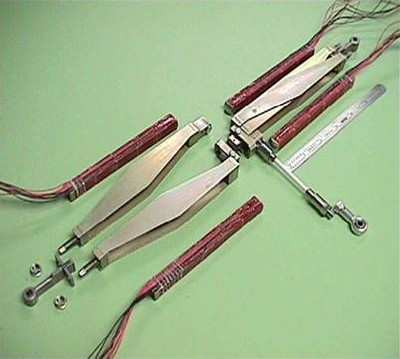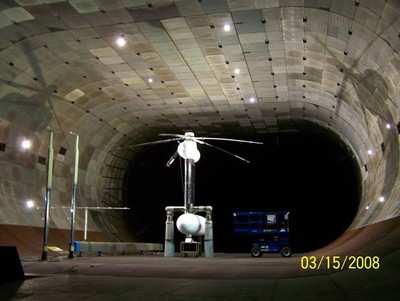Flexing Blades Could Make Helos More Efficient
Helicopters today are considered a loud, bumpy and inefficient
mode for day-to-day domestic travel... best reserved for medical
emergencies, traffic reporting and hovering over celebrity
weddings. But NASA research into rotor blades made with
shape-changing materials could change that view.

Twenty years from now, large rotorcraft could be making short
hops between cities such as New York and Washington, carrying as
many as 100 passengers at a time in comfort and safety.
Routine transportation by rotorcraft could help ease air traffic
congestion around the nation's airports. But noise and vibration
must be reduced significantly before the public can embrace the
idea.
"Today's limitations preclude us from having such an airplane,"
said William Warmbrodt, chief of the Aeromechanics Branch at NASA's
Ames Research Center in California, "so NASA is reaching beyond
today's technology for the future."
The solution could lie in rotor blades made with piezoelectric
materials that flex when subjected to electrical fields, not unlike
the way human muscles work when stimulated by a current of
electricity sent from the brain.
Helicopter rotors rely on passive designs, such as the blade
shape, to optimize the efficiency of the system. In contrast, an
airplane's wing has evolved to include flaps, slats and even the
ability to change its shape in flight.

NASA researchers and others are attempting to incorporate the
same characteristics and capabilities in a helicopter blade.
NASA and the Defense Advanced Research Projects Agency, also
known as DARPA, the U.S. Army, and The Boeing Company have spent
the past decade experimenting with smart material actuated rotor,
or SMART, technology, which includes the piezoelectric
materials.
"SMART rotor technology holds the promise of substantially
improving the performance of the rotor and allowing it to fly much
farther using the same amount of fuel, while also enabling much
quieter operations," Warmbrodt said.
There is more than just promise that SMART Rotor technology can
reduce noise significantly -- there's proof. The only full-scale
SMART Rotor ever constructed in the United States was run through a
series of wind tunnel tests between February and April 2008 in the
National Full-Scale Aerodynamics Complex at Ames. The SMART Rotor
partners joined with the US Air Force, which operates the tunnel,
to complete the demonstration.
A SMART Rotor using piezoelectric actuators to drive the
trailing edge flaps was tested in the 40- by 80-foot tunnel in
155-knot wind to simulate conditions the rotor design would
experience in high-speed forward flight. The rotor also was tested
at cruise speed conditions of 124 knots to determine which of three
trailing edge flap patterns produced the least vibration and noise.
One descent condition also was tested.
Results showed that the SMART Rotor can reduce by half the
amount of noise it puts out within the controlled environment of
the wind tunnel. The ultimate test of SMART rotor noise reduction
capability would come from flight tests on a real helicopter, where
the effects of noise that reproduces through the atmosphere and
around terrain could be evaluated as well.

The test data also will help future researchers use computers to
simulate how differently-shaped SMART Rotors would behave in flight
under various conditions of altitude and speed.
For now that remains tough to do. "Today's supercomputers are
unable to accurately model the unsteady physics of helicopter
rotors and their interaction with the air," Warmbrodt said. "But
we're working on it."
 Airborne 04.16.24: RV Update, Affordable Flying Expo, Diamond Lil
Airborne 04.16.24: RV Update, Affordable Flying Expo, Diamond Lil ANN's Daily Aero-Term (04.20.24): Light Gun
ANN's Daily Aero-Term (04.20.24): Light Gun Aero-News: Quote of the Day (04.20.24)
Aero-News: Quote of the Day (04.20.24) Aero-News: Quote of the Day (04.21.24)
Aero-News: Quote of the Day (04.21.24) ANN's Daily Aero-Term (04.21.24): Aircraft Conflict
ANN's Daily Aero-Term (04.21.24): Aircraft Conflict





